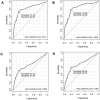Days alive and out of hospital at 30 days and outcomes of off-pump coronary artery bypass grafting
- PMID: 36849802
- PMCID: PMC9971038
- DOI: 10.1038/s41598-023-30321-8
Days alive and out of hospital at 30 days and outcomes of off-pump coronary artery bypass grafting
Abstract
Days alive and out of hospital (DAOH) is a simple estimator based on the number of days not in hospital within a defined period. In cases of mortality within the period, DAOH is regarded as zero. It has not been validated solely in off-pump coronary artery bypass grafting (OPCAB). This study aimed to demonstrate a correlation between DAOH and outcome of OPCAB. We identified 2211 OPCAB performed from January 2010 to August 2016. We calculated DAOH at 30 and 60 days. We generated a receiver-operating curve and compared outcomes. The median duration of hospital stay after OPCAB was 6 days. The median DAOH values at 30 and 60 days were 24 and 54 days. The estimated thresholds for 3-year mortality for DAOH at 30 and 60 days were 20 and 50 days. Three-year mortality was higher for short DAOH (1.2% vs. 5.7% and 1.1% vs. 5.6% DAOH at 30 and 60 days). After adjustment, the short DAOH 30 group showed significantly higher mortality during 3-year follow-up (hazard ratio 3.07; 95% confidence interval 1.45-6.52; p = 0.004). DAOH at 30 days after OPCAB showed a correlation with 3-year outcomes. DAOH 30 might be a reliable long-term outcome measure that can be obtained within 30 days after surgery.
© 2023. The Author(s).
Conflict of interest statement
The authors declare no competing interests.
Figures



Similar articles
-
Coronary artery bypass grafting in women--is OPCAB mandatory?Indian Heart J. 2011 Sep-Oct;63(5):425-8. Indian Heart J. 2011. PMID: 23550420
-
Effect of off-pump coronary artery bypass grafting on risk-adjusted and cumulative sum failure outcomes after coronary artery surgery.J Card Surg. 2002 Nov-Dec;17(6):520-8. doi: 10.1046/j.1540-8191.2002.01008.x. J Card Surg. 2002. PMID: 12643463
-
Days alive and out of hospital and graft survival after living donor liver transplantation.Ann Transl Med. 2023 Jun 30;11(9):308. doi: 10.21037/atm-22-6595. Epub 2023 Jun 5. Ann Transl Med. 2023. PMID: 37404994 Free PMC article.
-
Off-pump coronary artery bypass grafting improves short-term outcomes in high-risk patients compared with on-pump coronary artery bypass grafting: Meta-analysis.J Thorac Cardiovasc Surg. 2016 Jan;151(1):60-77.e1-58. doi: 10.1016/j.jtcvs.2015.08.042. Epub 2015 Aug 15. J Thorac Cardiovasc Surg. 2016. PMID: 26433633 Review.
-
Does off-pump coronary artery bypass surgery have a beneficial effect on mortality in patients with left ventricular dysfunction?Interact Cardiovasc Thorac Surg. 2012 Jun;14(6):856-64. doi: 10.1093/icvts/ivs067. Epub 2012 Mar 14. Interact Cardiovasc Thorac Surg. 2012. PMID: 22422876 Free PMC article. Review.
Cited by
-
Days at home after surgery as a perioperative outcome: scoping review and recommendations for use in health services research.Br J Surg. 2024 Nov 27;111(12):znae278. doi: 10.1093/bjs/znae278. Br J Surg. 2024. PMID: 39656657 Free PMC article.
-
Routine invasive strategy and frailty burden in non-ST-segment elevation acute myocardial infarction.J Geriatr Cardiol. 2024 Oct 28;21(10):954-961. doi: 10.26599/1671-5411.2024.10.005. J Geriatr Cardiol. 2024. PMID: 39619358 Free PMC article.
References
MeSH terms
LinkOut - more resources
Full Text Sources

